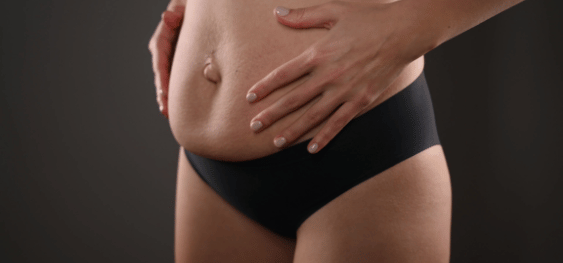One common complaint pelvic floor physical therapists hear from women post-partum is “I want to get rid of my pooch – I keep getting asked if I am pregnant again.” So what is the cause of this “pooch”? One cause may be a diastasis rectus abdominus – more commonly known as a “diastasis recti.”
What is Diastasis Recti and Why is it Important?
Diastasis recti occurs when there is a softening and widening of the linea alba, the collagenous connective tissue between the right and left rectus abdominus muscles. During pregnancy, the transverse abdominus (TA) and rectus abdominus (RA) muscles stretch and lengthen, allowing for expansion of the abdomen as baby grows, which creates a gap along the linea alba. Diastasis recti is most widely associated with pregnancy, although it can occur with weight gain or excessive straining during lifting, so even men or women who have not been pregnant can have a diastasis.
Diastasis recti width is measured by the number of fingers felt on the abdomen as you curl up, above and below the belly button. Typically, anything greater than 2 fingers is considered to indicate a diastasis. In addition to the width of the diastasis, depth is also important as this indicates tissue laxity within the deeper tissues. Medical professionals also look for “doming” or “tenting” of the abdominal wall with certain movements, such as a curl up or cough. Collectively, this information can help identify the appropriate type of exercise and level of difficulty to help improve the problem.
Recent research indicates that diastasis is present to some degree in all pregnant women at 35 weeks 1.3. In the weeks following delivery, the gap may close naturally with no remaining dysfunction. Examples of dysfunction may include low back or pelvic pain, abdominal pain, difficulty with exercise or daily activities, and pelvic floor dysfunction including incontinence or pelvic organ prolapse. Research has shown that 66% of women with a diastasis have stress urinary incontinence, fecal incontinence, and/or pelvic organ prolapse. 1,3,6
Part of the reason for this is that the connective tissues and muscles of the abdomen cannot function normally as a major support system to the lumbopelvic and abdominal region. Diane Lee is a Canadian Physiotherapist who likens this region of our bodies to a “canister.” 1 Think of this canister like a can of soda, the diaphragm muscle lines the top, the abdominal wall and lumbar muscles line the sides, and the pelvic floor muscles line the bottom. Diastasis represents a weakness in the canister at the linea alba. When this occurs, the TA and RA muscles cannot provide support to act as a counterforce to any increase in pressure. When the muscles and connective tissues remain lengthened, there is less support through the abdominal wall against increases in pressure with everyday activities including lifting, coughing, sneezing, and moving between positions. Many post-partum mothers with a persistent diastasis tend to notice a “tenting” or “doming” of the midline abdomen when sitting up in bed, with coughing, or with lifting. Typically this indicates that the TA muscle is not contracting well, allowing for pressure to be pushed forward in the abdomen and between the gap, giving the dome shape.
Healing is Variable, Takes Time, and Can be Influenced by Hormones
As mentioned before, recent literature shows prevalence of diastasis in 100% of pregnant women at 35 weeks gestation 1,3. This percentage drops to 39% at approximately 6-12 weeks post-partum, so for most women the separation will decrease naturally in the short-term.1,3 In the long term, it has been reported that if no intervention is performed then the separation at 8 weeks will be the same at 1 year.1 There is potential for closing or reducing this gap by strengthening the deep abdominal muscles along with avoiding activities and exercises which strain the linea alba.
For post-partum moms, there is an added consideration for the hormone relaxin. During pregnancy, this hormone affects connective tissue and joints to assist in preparing the body for delivery. Relaxin can exert its effects upon the linea alba for up to 5-6 months post-partum in moms who do not breastfeed; for moms who do breastfeed, relaxin is present both for the duration of nursing, plus a period of 5-6 months afterwards.2,5 All in all, it is good to remember that every woman’s body is different and tissue healing can naturally occur at different rates.
Closing the Gap May Not be Necessary to Restore Function
It may not all be about the gap. Recent research and clinical practice have shown that in women who have a persistent diastasis post-partum, some are able to achieve return to normalized function without complete closure of the diastasis gap.1,3 Clinically, pelvic floor physical therapists look at both the width of the separation and depth, in addition to how your body can support against forces during functional movement. Together, they use individualized rehabilitative exercise to improve abdominal wall function and connective tissue support with everyday activities. Progressive strengthening of the deep core can impact the way the abdominal wall responds to stress and impact, leading to increased stability and decreased discomfort during activity. The most important goal in diastasis rehabilitation is the patient’s ability to confidently and safely return to their usual activities.
Still, it is important to note that some women may not achieve normalized function following a course of rehabilitation, prescriptive exercises, and activity modification, and may require surgical repair.1,3 Physical therapy is still important even if you decide to pursue the surgical route. Surgery will close the gap, but will not impact abdominal muscle strength. Therefore, pre-hab and rehab before and after abdominal surgery can still be very effective.
There is a Potential to Improve Function Even with an “Old” Diastasis
With the right types of exercise, you may be able to work towards closing or improving a pre-existing diastasis.3 Potential for healing may depend on the severity of the diastasis (e.g. how large or extensive the separation is), the integrity of the connective tissue, and commitment to a home program. This may include exercises and modifying your movements or behaviors until you have healed to avoid worsening the diastasis.4 Some activities you might need to avoid include:
- Sit ups and curl ups
- Sitting straight up from lying on your back
- Straining while on the toilet
- Repetitive or heavy lifting
- Bulging the abdomen during exercise or daily activities
These activities may increase strain on the linea alba by increasing pressure in the abdomen, sending it to areas with low support. If you are working with a physical therapist, discuss your personal situation and problem-solve to find modifications to movements, recommendations for toileting, and exercise recommendations. You can help yourself as you are working on your diastasis by rolling to your side when sitting up in bed, maintain good posture, using good lifting mechanics, and managing persistent coughing, sneezing and constipation with your doctor.4
If you think you have a diastasis recti that may not have fully healed, you can always talk to your doctor or physical therapist about your concerns. Consulting a specialist can help to ensure that your individual body, lifestyle, and goals are integrated into your plan of action. Finally, always remember to be kind to your body and give it the space and time to heal.
Physical therapists at all four N2 locations are experienced in post-partum rehabilitation, and passionate about helping new moms get to the activities they love! Contact us to schedule your appointment for diastasis recti rehabilitation.
References
- Diastasis Rectus Abdominus & Postpartum Health. http://dianelee.ca/article-diastasis-rectus-abdominis.php. No date for publishing. Accessed May 15, 2018.
- Goldsmith, LT, Weiss, G. Relaxin in human pregnancy. Ann N Y Acad Scie. 2009;1160:130-135. https://www.ncbi.nlm.nih.gov/pubmed/19416173. Accessed May 15, 2018. Apr;1160:130-5. doi: 10.1111/j.1749-6632.2008.03800.x.
- Lee, D. Diastasis Rectus Abdominus: A Clinical Guide for Those Who are Split Down the Middle. Surrey, BC Canada: Learn; 2017
- Osborne, A. Bye Bye Mommy Tummy Closing Your Diastasis Recti: A Workshop for Postpartum Abdominal Separation. PDF Document accessed electronically May 22, 2018.
- Reese, E, Casey, E. Chapter 2: Hormonal Influence on the Neuromusculoskeletal System in Pregnancy in Musculoskeletal Health In Pregnancy and Postpartum: An Evidenced Based Guide. Switzerland: Springer; 2015. DOI 10.1007/978-3-319-14319-4_2
- Spitznagle TM, Leong FC, van Dillen LR 2007 Prevalence of diastasis recti abdominis in a urogynecological patient population. Int Urogynecology J 18:3

